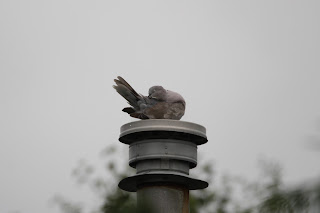It was a cloudy day, and as the 'Burg Birder would say..."It's the weekend!"
When we arrived at the location (Elmira Rd. S) the bird was nowhere to be seen. So we turned onto Stephanie Dr., then typed "Cherrywood Drive" into the GPS (we call her Lady Nav), as I had remembered reading about Cherrywood some where along the line. As soon as we pushed "Go" the voice said "Arriving at Cherywood Drive on right". We pulled forward 5 feet and revealed the street sign that was concealed by a pine. Not 15 feet away from where we entered the street, I spotted the dove on top of one of those vent thingies.
We left in less than 10 minutes because it's a residential area, and the occupants probably wouldn't like me looking at their homes with binoculars. It's bad enough that on Nature London trips we usually find ourselves looking at people's feeders!
A shortish drive later, we find ourselves in Hamilton. There are a lot of Double-crested Cormorants, and I saw a nesting colony close to the highway.
I haven't seen this many since Pelee Island last fall.
Windermere Basin was home to a Snowy Egret for a few days, but it wasn't there when we went. There were however tons of Caspian and Common Terns, as both breed in the area. I'm still kicking myself for not getting a decent shot of the terns, as they flew right over!
Some others birds seen were Ring-billed Gulls, DC Cormorants, Mallards, Canada Geese, and a female Rudy Duck.
Shorebirds are starting to arrive, and I saw 5 species. Solitary Sandpiper, Stilt Sandpiper, Least Sandpiper, Short-billed Dowitcher, and Killdeer.
After the basin, we went down to Queenston Heights park in the Niagara region. I was hoping for Black Vultures, but I found out they don't hang around during the summer months. All I saw were Turkey Vultures.
And now some information for history buffs like me...
The Battle of Queenston Heights was fought on October 13, 1812. This is perhaps one of the best known battles of the War of 1812. The Americans decided to cross at Queenston, so they sent a small militia group on the 12th. General Sir Isaac Brock thought that the militia was a distraction, as crossing the Niagara currents isn't easy, and it would be much easier to cross at Fort George. So, Brock kept most of his men at the fort, but sent a few to Queenston.
It turned out that the Americans were intent on taken Queenston, so on the morning of the 13th, Brock woke to the sound of guns. He rode his horse all the way there, organized his troops, then personally lead the charge down the hill with his sword drawn. Unlike other generals, Brock liked to lead his men and not just direct them. His bravery lead to the victory of the British, but he was sadly killed by an unknown sniper. He was one of the 28 non-American causalities.
A monument was erected in his name, 182 feet tall. The monument is found on the longest un-defended border in the entire world. Brock's remains can be found here.
It is kind of neat that 200 years ago, men were running down these paths, fighting for their lives.
Its black, but not a vulture!
I didn't find anything out of the ordinary, but I spotted a lifer butterfly...Red-spotted Purple!
I can only imagine trying to cross this in 1812.
The clouds cleared up and revealed a rainbow.
A nice ending to a awesome day. I finally tracked down a rare dove! It almost makes up for missing the White-winged Dove by TEN minutes back in June :)
 |
| These birds are eating the WWDO's seeds! |
Good birding!




















Great to hear that you got to see the collared dove. Been a while since I've seen one, but it sounds as if it's only a matter of time before they become more regular in Ontario.
ReplyDeleteI don't get down Niagara way as often as I would like, so it's great to be able to visit the area through your blog post :)
Thanks Jonathan!
Delete